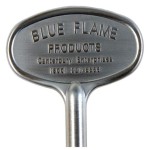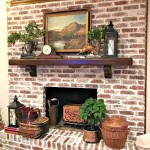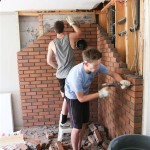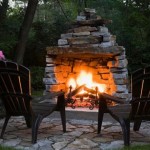If You Have a Gas Fireplace, Do You Need to Open the Flue?
The question of whether to open the flue (also often called the damper) when operating a gas fireplace is a critical one, impacting both safety and efficiency. While the short answer is generally yes, understanding the nuances surrounding different types of gas fireplaces and their venting requirements is essential. Failure to operate a gas fireplace with the appropriate flue setting can lead to hazardous conditions, including carbon monoxide poisoning. This article will delve into the reasons why opening the flue is often necessary, the exceptions to the rule, and the potential dangers of improper operation.
Historically, fireplaces were designed exclusively for burning wood. These fireplaces relied on a chimney and flue to exhaust smoke and combustion byproducts outside the home. The flue, a movable plate within the chimney, regulates the airflow and prevents drafts when the fireplace is not in use. When gas fireplaces were introduced, they often utilized existing chimney structures, creating a need to understand how flue operation should be adapted for this new fuel source.
The primary function of a flue is to provide a pathway for gases to escape the house. When combusted, natural gas and propane produce carbon dioxide, water vapor, and potentially, carbon monoxide if the combustion is incomplete. While carbon dioxide is relatively harmless in small quantities, carbon monoxide is a deadly, odorless, and colorless gas. A properly functioning flue ensures these gases are safely vented outdoors, preventing them from accumulating within the living space.
Different types of gas fireplaces have varying venting requirements. Understanding these differences is crucial for safe and efficient operation. The two main types of gas fireplaces are vented and vent-free (also known as ventless). These fireplaces operate under distinctly different principles and require different approaches to flue operation.
Vented Gas Fireplaces and the Importance of Opening the Flue
Vented gas fireplaces are designed to mimic the look and feel of traditional wood-burning fireplaces. They feature realistic-looking flames and often include artificial logs. The key characteristic of a vented gas fireplace is its reliance on a chimney or vent system to exhaust combustion byproducts. These fireplaces are designed under the assumption that all exhaust gases will be directed outdoors.
When operating a vented gas fireplace, opening the flue is absolutely essential. The open flue provides the necessary pathway for carbon monoxide and other combustion byproducts to escape. Operating a vented gas fireplace with a closed flue can lead to a rapid buildup of carbon monoxide inside the home, creating a life-threatening situation. Even with a modern carbon monoxide detector, relying on it as the sole safety measure is unwise. Proper ventilation through an open flue is the primary line of defense.
The size of the flue opening is also important. It should be fully open to allow for maximum airflow. A partially open flue may not provide sufficient ventilation, particularly during periods of low atmospheric pressure or strong downdrafts. Periodically inspect the flue and chimney to ensure they are free from obstructions, such as bird nests or debris, which could impede airflow.
Signs that a vented gas fireplace is not adequately ventilated include a smoky odor inside the house, headaches, dizziness, nausea, or flu-like symptoms. Carbon monoxide detectors are crucial safety devices, but they should be regarded as a backup measure, not a substitute for proper flue operation. If a carbon monoxide detector alarms, immediately evacuate the premises and contact emergency services.
Many homeowners install carbon monoxide detectors near their gas fireplaces as an added precaution. It is recommended that you have a carbon monoxide detector installed to ensure your gas fireplace is working safely.
Vent-Free Gas Fireplaces and Specific Flue Considerations
Vent-free gas fireplaces, as the name suggests, are designed to operate without a traditional chimney or vent system. These fireplaces are engineered to burn gas very efficiently, minimizing the production of carbon monoxide. They often incorporate oxygen depletion sensors (ODS) that shut off the gas supply if the oxygen level in the room drops to an unsafe level, which indicates a potential buildup of carbon monoxide.
Contrary to vented gas fireplaces, vent-free gas fireplaces are designed to be operated with the flue closed and permanently sealed or removed. Opening the flue on a vent-free gas fireplace would defeat the purpose of its design, allowing heat to escape and potentially disrupting the combustion process. A vent-free fireplace relies on the ODS sensor to operate safely, which functions only because the space is somewhat closed and unvented.
Despite their name, vent-free gas fireplaces still require some level of ventilation. They are designed to be used in well-ventilated rooms to ensure adequate oxygen supply. Manufacturers typically specify minimum room size requirements and recommend opening a window slightly during operation. Failure to adhere to these recommendations can lead to oxygen depletion and the buildup of combustion byproducts, even with a properly functioning ODS sensor.
It is imperative to strictly adhere to the manufacturer's instructions regarding ventilation and operation of vent-free gas fireplaces. These units are designed to operate within specific parameters, and deviating from these guidelines can compromise safety. Regular maintenance, including cleaning the burner and checking the ODS sensor, is also essential.
Many people assume that because a vent-free fireplace has an ODS sensor that they can operate it without worrying about proper ventilation. It is very important to always have some form of ventilation when operating a vent-free gas fireplace.
Determining Your Fireplace Type and Ensuring Safe Operation
The most crucial step in determining whether to open the flue is identifying the type of gas fireplace you have. A vented gas fireplace will be connected to a chimney or vent system that leads outdoors. The flue will be located within the chimney, typically operated by a handle or lever. A vent-free gas fireplace will lack a chimney or vent system and will typically have a permanently closed or absent flue.
If you are unsure whether your gas fireplace is vented or vent-free, consult the manufacturer's instructions or contact a qualified HVAC technician or fireplace installer. Do not operate the fireplace until you have definitively determined its type and understand its venting requirements. Operating a fireplace with the incorrect flue setting can have serious consequences.
Regardless of the type of gas fireplace you have, regular maintenance is essential for safe and efficient operation. This includes inspecting the burner for clogs or debris, cleaning the glass enclosure, and checking the condition of the venting system (if applicable). A qualified technician should inspect vented gas fireplaces and chimneys annually to ensure they are free from obstructions and functioning properly.
For older homes with existing chimneys, it is crucial to ensure the chimney is properly lined. An unlined or poorly lined chimney can allow combustion byproducts to leak into the house, even with the flue open. A chimney sweep can inspect the chimney liner and recommend repairs or replacement if necessary.
Consider installing a dual carbon monoxide and smoke detector, which offers extra protection against the possibility of CO poisoning. Routinely check the batteries in your alarms to make sure that they are still working.
Finally, always prioritize safety when operating a gas fireplace. Never leave a gas fireplace unattended, especially if children or pets are present. Ensure that all users of the fireplace understand the importance of proper ventilation and the potential dangers of carbon monoxide poisoning. By following these guidelines, you can enjoy the warmth and ambiance of a gas fireplace safely and efficiently.

If You Have A Gas Fireplace It May Or Not Chimney Flue

How To Open A Chimney Damper Traditional Fireplace Pros

Do Gas Fireplaces Need A Chimney Dreifuss

Vented Vs B Vent Direct Free Dixie S

When To Close My Fireplace Damper We Love Fire

Do You Need A Flue For Gas Stove Direct Stoves

How To Vent A Gas Fireplace Without Chimney Vertical Care

Do You Need A Flue For Gas Stove Direct Stoves

Converting An Open Fire To A Gas Direct Fireplaces

How To Tell If A Fireplace Damper Is Open Or Closed Vertical Chimney Care








